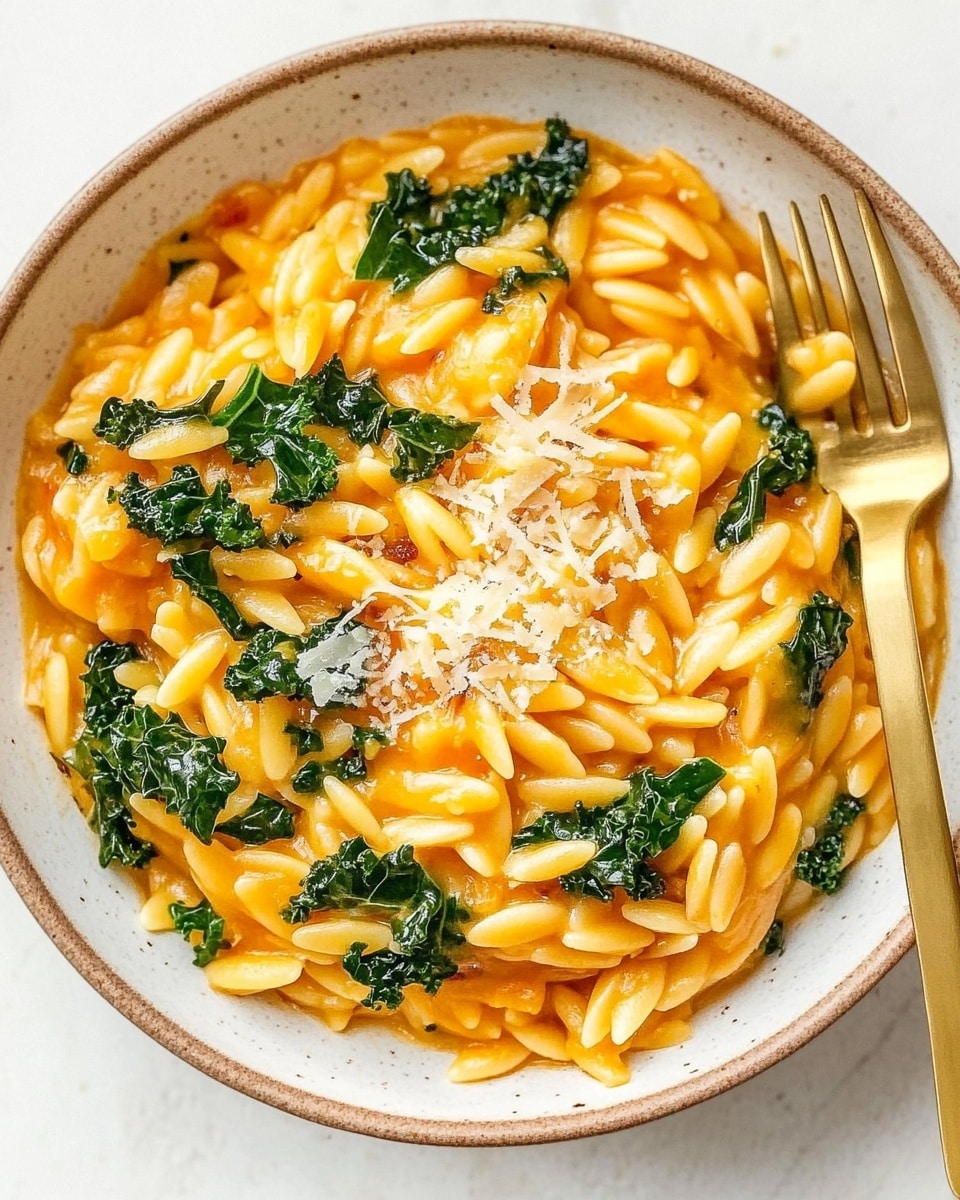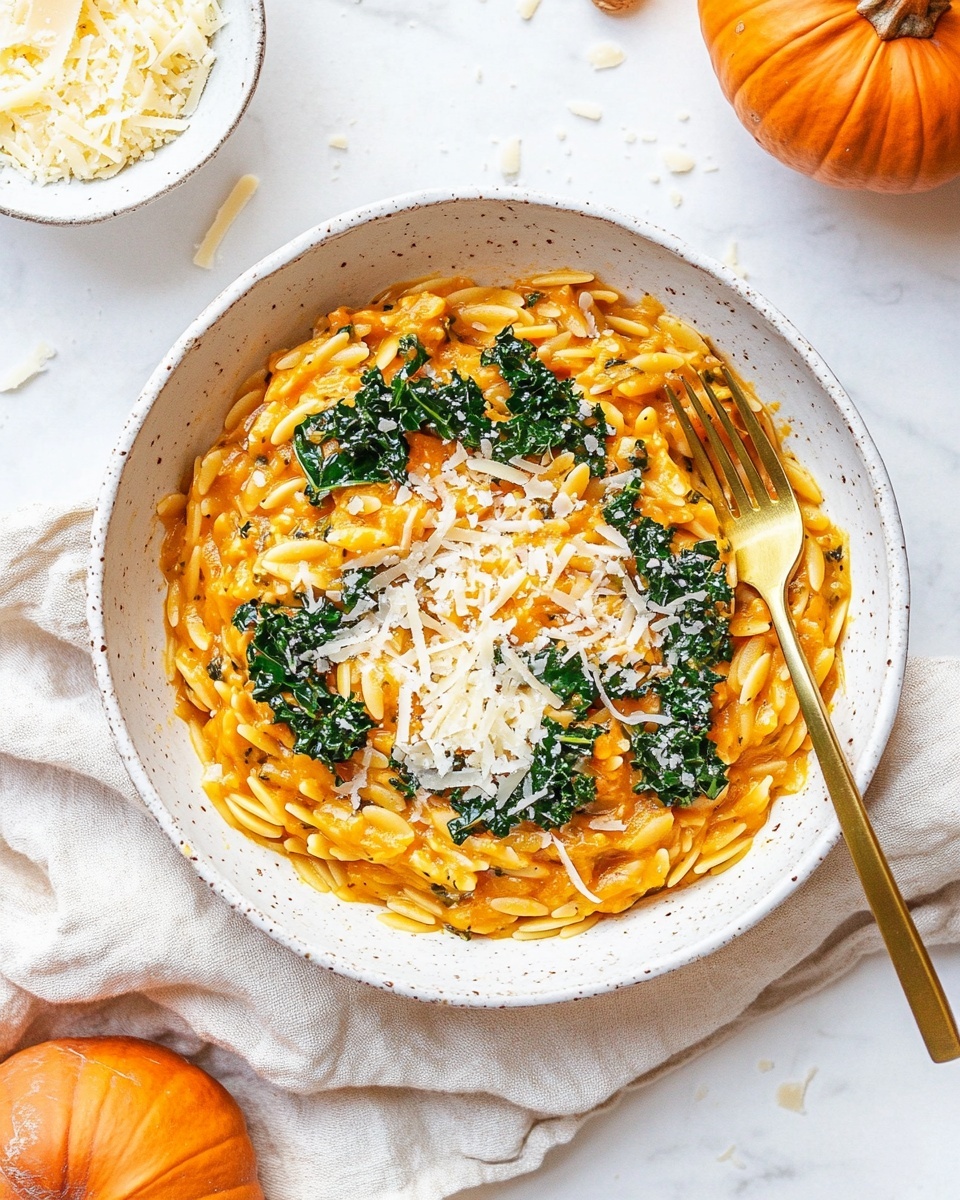I absolutely love how this Creamy Roasted Butternut Squash and Kale Orzo Pasta Recipe combines comforting creaminess with the sweetness of roasted squash and the earthiness of kale. It’s one of those dishes that feels cozy and special at the same time — perfect for cooler nights or when you want a meal that’s both hearty and fresh. You’ll find that the roasted butternut squash adds a lovely caramelized flavor that pairs beautifully with the tender orzo pasta, making it a dish you’ll come back to time and again.
When I first tried this recipe, I was amazed at how simple ingredients could come together to create something this luscious without relying on heavy cream. The velvety texture comes from stirring in Parmesan cheese and cooking the orzo slowly in vegetable stock, which makes the whole thing feel indulgent but still light. Whether you’re cooking for family or entertaining friends, this Creamy Roasted Butternut Squash and Kale Orzo Pasta Recipe is a guaranteed crowd-pleaser that’s as delicious the next day as it is fresh from the stove.
Why You’ll Love This Recipe
- Rich Flavor Without Cream: Roasting the squash brings out sweet, caramelized notes, while the orzo pasta cooks creamy from vegetable stock and Parmesan.
- Easy One-Pan Cooking: Most of the cooking happens in one pan, meaning less mess and more time to enjoy your meal.
- Nutritious and Comforting: This dish packs fiber and vitamins from kale and squash, making it healthy and satisfying.
- Perfect for Any Occasion: Whether you’re meal prepping, hosting a weeknight dinner, or looking for cozy comfort food, this recipe fits the bill.
Ingredients You’ll Need
When you gather the ingredients for this Creamy Roasted Butternut Squash and Kale Orzo Pasta Recipe, you’ll see it’s all about fresh, simple components that complement each other perfectly. I like to pick a firm butternut squash and fresh kale (cavolo nero if you can find it) for the best texture and flavor.
- Butternut Squash: Look for a medium to large squash, peeled and cubed; roasting it intensifies sweetness beautifully.
- Shallots: These add a subtle, mild onion flavor that’s less sharp – perfect for gentle sautéing.
- Garlic: Freshly minced garlic gives a lovely aromatic lift without overpowering the dish.
- Fresh Sage Leaves: If possible, use fresh sage for its vibrant, earthy aroma, but dried works in a pinch.
- Kale (Cavolo Nero recommended): Adds color, nutrition, and a slightly chewy texture that stands up well in this creamy pasta.
- Orzo Pasta: Choose quality orzo for the perfect tiny pasta shape that soaks up all the flavors.
- Vegetable Stock: This is your cooking liquid and flavor base, so use a good quality, low-sodium stock if possible.
- Olive Oil: For roasting and sautéing, bringing rich herbal notes and richness to the dish.
- Parmesan Cheese: Freshly grated Parmesan builds the creamy texture and adds a savory punch.
- Salt and Pepper: Season to taste – it’s key to bringing all the flavors together.
Variations
I love how versatile this Creamy Roasted Butternut Squash and Kale Orzo Pasta Recipe is, so I always encourage you to personalize it based on your tastes or dietary needs. Playing with the greens or swapping Parmesan for something vegan doesn’t just make it your own but also keeps the recipe fresh and exciting.
- Vegan Version: I’ve swapped Parmesan for nutritional yeast or a vegan cheese alternative with great results — it keeps the creaminess without dairy.
- Greens Swap: If you can’t find cavolo nero, baby spinach or even chard work beautifully, just add them toward the end so they don’t overcook.
- Protein Addition: Sometimes I toss in white beans or cooked chicken for a heartier meal, especially when feeding a hungry family.
- Spice it Up: Adding a pinch of red pepper flakes or smoked paprika gives the dish a nice little kick if you’re craving some heat.
How to Make Creamy Roasted Butternut Squash and Kale Orzo Pasta Recipe
Step 1: Roast the Butternut Squash Until Golden and Tender
Preheat your oven to 200°C (400°F). After peeling, deseeding, and cubing the butternut squash, toss it with 1 tablespoon of olive oil, some salt, and pepper. Spread it out on a baking sheet evenly, then scatter 4 to 5 sage leaves over the top. Roast for about 45 minutes or until the squash cubes develop a gorgeous golden caramelization and feel tender when pierced with a fork. I like to give the pan a shake halfway through to ensure even roasting. This step is the flavor cornerstone of the dish — don’t rush it!
Step 2: Sauté Shallots, Garlic, and Sage
About 20 minutes before the squash finishes roasting, heat the remaining tablespoon of olive oil in a deep sauté pan over low heat. Add finely chopped shallots, minced garlic, and the remaining sage leaves (minced if fresh). Cook gently for 2 to 3 minutes, stirring often, until everything turns soft and fragrant — but be careful not to brown the garlic or shallots, as that can introduce bitterness. This aromatic base will infuse the dish with subtle herbaceous notes.
Step 3: Cook the Orzo Pasta Creamy in Stock with Kale
Pour 1 litre of vegetable stock into the pan with the sautéed aromatics and add the chopped kale. Bring to a boil, then add the orzo pasta along with some salt to taste. Lower the heat slightly to maintain a gentle boil and cook the orzo for about 7 to 8 minutes, stirring frequently. This frequent stirring prevents sticking and encourages the pasta to release starch, which helps create that luxuriously creamy, risotto-like texture. Keep an eye on your liquid levels — if the mixture thickens too fast, add up to an additional ½ cup of stock or water to keep things nice and loose.
Step 4: Finish with Parmesan and Top with Roasted Squash
When the orzo is tender but still has a slight bite (al dente), remove the pan from the heat. Stir in freshly grated Parmesan cheese, which melts into the pasta to create that signature creaminess. Taste and adjust the seasoning with more salt and pepper if needed. Serve the pasta warm, topped generously with the golden roasted butternut squash. I love how the contrast between the creamy pasta and the sweet, roasted squash just sings on the palate — it’s comfort food elevated.
Pro Tips for Making Creamy Roasted Butternut Squash and Kale Orzo Pasta Recipe
- Roast Squash Evenly: Don’t overcrowd the pan while roasting squash cubes — this ensures they get those perfect crispy edges.
- Gentle Heat for Aromatics: Sauté your shallots and garlic on low heat to soften without browning — it keeps the flavors delicate yet complex.
- Stir Orzo Frequently: This is the key to creamy pasta, so keep stirring and adding small amounts of stock as needed to prevent clumping.
- Parmesan Timing: Always add the cheese off the heat to avoid curdling and keep that smooth, creamy texture you want.
How to Serve Creamy Roasted Butternut Squash and Kale Orzo Pasta Recipe

Garnishes
I typically finish this dish with a sprinkle of extra Parmesan and a few fresh sage leaves or cracked black pepper for a pretty, aromatic touch. Sometimes a drizzle of good-quality extra virgin olive oil just before serving amps up the richness and shine. For a little fresh brightness, a squeeze of lemon juice or a handful of toasted pine nuts adds a delightful contrast — I highly recommend trying these if you want to experiment.
Side Dishes
This pasta is a satisfying main dish, but I often serve it with a crisp green salad dressed lightly with citrus vinaigrette to cut through the richness. Roasted Brussels sprouts or a simple sauté of green beans with garlic makes a tasty seasonal side, especially in fall and winter. Garlic bread or crusty focaccia is also incredible alongside when you want to keep things indulgent.
Creative Ways to Present
For special occasions, I like to serve this Creamy Roasted Butternut Squash and Kale Orzo Pasta Recipe in shallow bowls topped with a colorful scattering of microgreens or edible flowers — it makes an impression without extra effort. Another fun idea is to spoon it into hollowed acorn squash halves for a festive autumnal presentation. It’s amazing how a few small touches easily elevate it from weeknight dinner to gathering centerpiece!
Make Ahead and Storage
Storing Leftovers
I store leftovers in an airtight container in the fridge for up to 3 days. Because orzo tends to absorb liquid over time, the pasta thickens, so I usually stir in a splash of vegetable stock or water before reheating to bring back the creamy texture you love. Leftover roasted squash holds up beautifully too — it just gets even more flavorful overnight!
Freezing
Freezing this pasta is possible but with a slight tradeoff in texture. I recommend freezing before adding Parmesan cheese for best results. When you’re ready to eat, thaw thoroughly and stir in fresh Parmesan and a splash of stock while gently reheating. This preserves creaminess better than freezing the fully finished dish.
Reheating
Reheat leftovers gently in a skillet over medium-low heat with a little vegetable stock or water added to loosen the pasta. Stir frequently to prevent sticking and to restore that silky consistency. Avoid microwaving straight from the fridge without loosening liquids first, as the pasta can dry out or become clumpy.
FAQs
-
Can I use a different type of pasta for this recipe?
Absolutely! While orzo works best to achieve the creamy, risotto-like texture, you can substitute with small shapes like acini di pepe, or even short-cut pasta such as small shells or ditalini. Just adjust cooking time and liquid accordingly, aiming for a tender but slightly firm bite.
-
Is it possible to make this recipe gluten-free?
Yes, you can swap the orzo for a gluten-free small pasta or use gluten-free couscous. Keep in mind that cooking times and texture might vary slightly, so check frequently to avoid overcooking.
-
How do I get the orzo to be creamy without cream?
The secret is cooking the orzo slowly in vegetable stock and stirring frequently, which releases the pasta’s starch to create a natural creaminess. Adding Parmesan cheese off the heat further enriches the dish, giving you that luscious texture without needing heavy cream.
-
Can I make this recipe vegan?
Definitely! Replace the Parmesan cheese with nutritional yeast or a vegan cheese alternative, and ensure your vegetable stock is vegan-friendly. This keeps the creamy feel and cheesy flavor but suits plant-based diets.
-
What’s the best way to store and reheat leftovers?
Store leftovers in an airtight container in the fridge for up to 3 days. When reheating, warm the pasta on the stove with a splash of vegetable stock and stir gently to bring back creaminess. Avoid microwaving straight away without loosening the sauce as it can dry out.
Final Thoughts
This Creamy Roasted Butternut Squash and Kale Orzo Pasta Recipe holds a special place in my kitchen because it marries simplicity with soul-warming flavor. It’s the perfect cozy meal that doesn’t rely on complicated ingredients or techniques yet delivers a richness that feels luxurious. I encourage you to try it soon—once you taste the beautifully roasted squash with tender orzo and kale, you’ll see why it’s become such a beloved recipe in my home. Trust me, your family and friends will be asking for seconds before you know it!
Print
Creamy Roasted Butternut Squash and Kale Orzo Pasta Recipe
- Prep Time: 15 minutes
- Cook Time: 1 hour 10 minutes
- Total Time: 1 hour 25 minutes
- Yield: 6 servings
- Category: Main Course
- Method: Roasting
- Cuisine: Italian
- Diet: Vegetarian
Description
This creamy roasted butternut squash and kale orzo pasta is a comforting and flavorful dish combining the sweetness of caramelized squash with tender kale and a Parmesan-infused creamy orzo. Roasting the squash enhances its natural sweetness while the sautéed aromatics and fresh sage add fragrant depth. The orzo is cooked gently in vegetable stock to achieve a luscious, risotto-like texture, making for a hearty yet elegant vegetarian meal perfect for cozy dinners.
Ingredients
Vegetables and Herbs
- 1 butternut squash, large, approximately 2 lbs (1 kg), peeled, deseeded, and cut into bite-sized cubes
- 2 shallots, finely chopped
- 2-3 cloves garlic, minced
- 10 leaves fresh sage, divided (or 0.5 tsp dried sage)
- 100g (1 cup) kale, chopped (cavolo nero recommended)
Dry Ingredients
- 500g (2.5 cups) orzo pasta
Liquids and Oils
- 1 litre + 250 ml (5 cups + 0.5 cup) vegetable stock
- 2 tbsp olive oil, divided
Dairy
- 50g (3/4 cup) freshly grated Parmesan cheese
Seasoning
- Salt and pepper, to taste
Instructions
- Preheat and Prepare Squash: Preheat the oven to 200°C (400°F). Peel, deseed, and cut the butternut squash into bite-sized cubes. Toss the squash cubes with 1 tablespoon olive oil, salt, and pepper. Spread evenly on a shallow baking pan and scatter 4-5 fresh sage leaves over the squash. Roast for 45 minutes until the squash is golden and caramelized.
- Sauté Aromatics: About 20 minutes before the squash finishes roasting, heat the remaining 1 tablespoon olive oil in a deep pan over low heat. Add chopped shallots, minced garlic, and the remaining sage leaves (finely chopped if fresh or dried). Sauté gently for 2-3 minutes until fragrant and softened without browning.
- Cook Orzo: Pour 1 litre of vegetable stock into the pan with the aromatics and kale. Bring to a boil. Add the orzo and salt to taste, then reduce heat slightly to maintain a gentle boil. Cook, stirring frequently, for 7-8 minutes until orzo is tender but al dente and the mixture is creamy. If too thick, add up to 0.5 cup more vegetable stock to loosen.
- Finish the Dish: Remove the pan from heat. Stir in freshly grated Parmesan cheese and adjust salt as needed. Serve the creamy orzo topped generously with the roasted butternut squash. Serve warm.
Notes
- Stir orzo frequently while cooking to prevent sticking and to help create the creamy texture.
- If cavolo nero is unavailable, substitute with kale or other sturdy greens like spinach.
- For a vegan version, replace Parmesan with nutritional yeast or a vegan cheese alternative.
- Use fresh sage if possible for better flavor; reduce amount if using dried sage.
- Adjust liquid by adding extra vegetable stock as needed to maintain creaminess.
Nutrition
- Serving Size: 1 serving
- Calories: 320 kcal
- Sugar: 4 g
- Sodium: 470 mg
- Fat: 9 g
- Saturated Fat: 3 g
- Unsaturated Fat: 6 g
- Trans Fat: 0 g
- Carbohydrates: 48 g
- Fiber: 5 g
- Protein: 12 g
- Cholesterol: 12 mg









